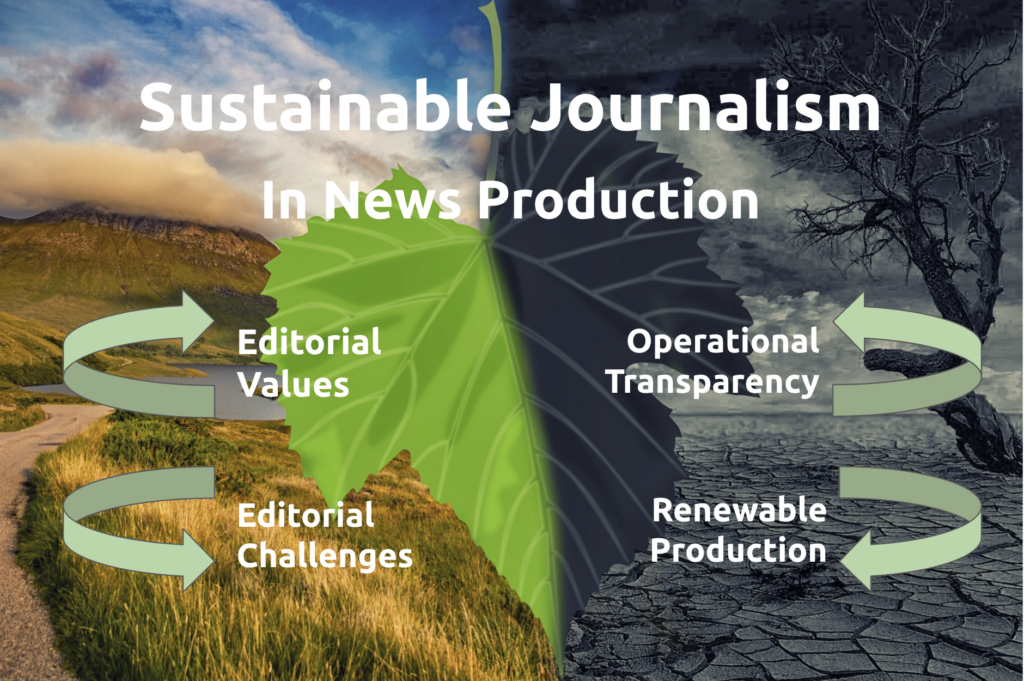
The Sustainable Journalism Partnership is a global network of media leaders, journalists and researchers working together to establish how journalism can be made more sustainable and at the same time contribute to a sustainable world.
The following is an attempt to define an ideal practice of sustainable journalism. It is a work in progress — additional remarks are welcome. Hopefully the following bullet points will serve as inspiration if you wish to participate in the development of the concept.
Values
The foundation is built on established ideals, where journalism:
- As its first obligation, demonstrates the presentation of the truth.
- As its first principle, remains loyal to the idea of public interest.
- Is based on fact checking, source verification, and a scientific approach, and stands in contrast to disinformation.
- Functions as an independent monitor of power, maintaining an independence from those reported on.
- Becomes a forum for public criticism and debate.
- Communicates what is significant to citizens in an interesting, relevant, and engaging way.
- Holds those in power to account.
Challenges
Besides these more traditional ideals, the sustainability challenges of our time put even higher demands on journalism; namely that it:
- Is able to meet the needs of the present without compromising the ability of future generations to meet their own needs, addressing the overarching challenges of our time — environmental, economic, and social sustainability.
- Is gender-sensitive, inclusive, and conflict-sensitive. Publishing should be the result of a conscious decision related to consequences. However, publishing may well be defendable even if the consequences are undesirable, if the story contains information that the public needs to know to be able to make informed decisions.
- Avoids harmful simplifications, and steers clear of news that is meant to shock rather than inform.
- Is solution-oriented, not only describing problems but also posing questions that point to possible solutions for a future sustainable world.
- Is entrepreneurial, searching for innovative ways to ensure financial independence.
- Openly takes on the driving of positive change by reporting about how climate change already impacts people around the world, including natural disasters and extreme weather.
- Gives space to voices about climate crises, from acknowledged experts and from those affected.
- Reports on innovative initiatives for environmental, social, and economic sustainability.
- Helps users to live sustainably when reporting on issues such as food, travel, and lifestyle.
- Undertakes investigations into the economic and political structures that underpin the carbon economy, and examines the role the climate crisis plays in many other critical issues, including inequality, migration, and the battle for scarce resources.
- Uses a language that recognises the severity of the climate crisis; a language that accurately describes the environmental crises facing the world and that is scientifically precise, while also communicating clearly with readers on the urgency of this issue.
- Preferably, is developed through engagement and connection with surrounding society. Participation, interactivity, and engagement are key concepts in this context.
- Strives to find new ways of telling stories and to explain the world, not least for the younger generation. Visionary storytelling is therefore at the heart of sustainable journalism.
- Strives to connect the local with the global. Change may happen locally, but most changes are closely connected to global events and networks, and vice versa.
- May be driven by interest organisations — but if this is the case, the obligation to tell the truth and loyalty to citizens must come as a first priority. Distorted or incomplete information can never be considered sustainable journalism, even if it would serve a higher purpose or agenda.
- Requires that practitioners of sustainable journalism not only master professional journalistic skills, but also have thorough thematic knowledge of the overarching challenges of our time, such as climate change, democracy, equality, gender equity, and inclusion.
- Requires practitioners of sustainable journalism to avoid pretending that they can “stand outside reality and objectively describe it,” as if they were free of bias and liberated from their personal experiences and culture. This was not what pioneers of modern journalism meant when they invented the concept of “objective journalism.” It was out of a growing recognition that journalists were full of bias, often unconsciously. Objectivity called for journalists to develop a consistent method of testing information — a transparent approach to evidence — so that personal and cultural biases would not undermine the accuracy of their work. This approach is also valid for sustainable journalism.
Transparency
Transparency is a precondition for sustainable journalism.
It is not just the content that determines whether journalism is sustainable or not, it is also the transparency of the company or organisation behind the publication.
Publishers should:
- Strive to never publish false content. If false content is published by mistake, it must be rapidly corrected.
- Refer to fact-checked sources, preferably first-hand information or trustworthy, credible second-hand news sources.
- Transparently account for the sources and working methods that have been used when publishing a story.
- Avoid deceptive headlines that contain false information, or otherwise do not reflect what is actually in the story.
- Not distort or misrepresent information to make an argument.
- Distinguish opinion from news reporting in a responsible manner. If the reporting expresses a particular point of view, this should be clearly stated — including who expresses the view, and from what perspective it is conveyed.
- Clearly display which content is paid for and which is not.
- Clearly and accessibly provide the names of content creators, along with either contact or brief biographical information.
- Make clear how an error or complaint by a reader/viewer/listener should be reported.
- Establish effective practices for publishing clarifications and corrections, and note corrections in a transparent way.
- Clearly disclose ownership and/or financing, as well as any notable ideological or political positions held by those with a significant financial interest in the site, in a user-friendly manner.
Sustainable production
The production process must comply with the demands of social, economic, and environmental sustainability. This could be a very long list, but, as conditions vary depending on the size and nature of the publishing unit, here are just some examples:
- Set targets (including reducing carbon emissions) in line with science-based methodology.
- Cut the use of single-use plastic.
- Develop a detailed long-term plan on how to achieve net zero emissions.
- Buy renewable electricity.
- Offer training and awareness capacity-building for staff on sustainability.
- Strive to follow the guidelines of the UN Global Compact and Certified B Corporations.
About the Sustainable Journalism Partnership
The partnership exists to:
- Define sustainable journalism as a new research area, opening up for new research projects
- Find out what kind of journalism that effectively communicates sustainability challenges
- Find out what kind of sustainable journalism the public is willing to pay for
- Communicate successful sustainable business models for media in middle- and low-income countries
- Communicate environmentally sustainable production and distribution models
- Develop knowledge on how to set up a socially sustainable newsroom
- Develop trainings in sustainable journalism reporting
- Develop a syllabus on sustainable journalism for schools of journalism
Anyone is welcome to apply for membership of the Sustainable Journalism Partnership. Once accepted you can join other media professionals around the world who are working together to take media viability to the next level. You will receive a monthly newsletter with first-hand information and resources on sustainable journalism as well as access to a community of like minded people.








